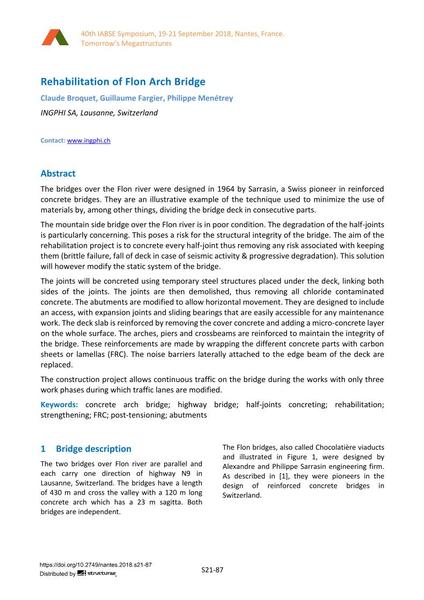Rehabilitation of Flon Arch Bridge

|
|
|||||||||||
Détails bibliographiques
| Auteur(s): |
Claude Broquet
(INGPHI SA, Lausanne, Switzerland)
Guillaume Fargier (INGPHI SA, Lausanne, Switzerland) Philippe Menétrey (INGPHI SA, Lausanne, Switzerland) |
||||
|---|---|---|---|---|---|
| Médium: | papier de conférence | ||||
| Langue(s): | anglais | ||||
| Conférence: | IABSE Symposium: Tomorrow’s Megastructures, Nantes, France, 19-21 September 2018 | ||||
| Publié dans: | IABSE Symposium Nantes 2018 | ||||
|
|||||
| Page(s): | S21-87 | ||||
| Nombre total de pages (du PDF): | 8 | ||||
| DOI: | 10.2749/nantes.2018.s21-87 | ||||
| Abstrait: |
The bridges over the Flon river were designed in 1964 by Sarrasin, a Swiss pioneer in reinforced concrete bridges. They are an illustrative example of the technique used to minimize the use of materials by, among other things, dividing the bridge deck in consecutive parts. The mountain side bridge over the Flon river is in poor condition. The degradation of the half-joints is particularly concerning. This poses a risk for the structural integrity of the bridge. The aim of the rehabilitation project is to concrete every half-joint thus removing any risk associated with keeping them (brittle failure, fall of deck in case of seismic activity & progressive degradation). This solution will however modify the static system of the bridge. The joints will be concreted using temporary steel structures placed under the deck, linking both sides of the joints. The joints are then demolished, thus removing all chloride contaminated concrete. The abutments are modified to allow horizontal movement. They are designed to include an access, with expansion joints and sliding bearings that are easily accessible for any maintenance work. The deck slab is reinforced by removing the cover concrete and adding a micro-concrete layer on the whole surface. The arches, piers and crossbeams are reinforced to maintain the integrity of the bridge. These reinforcements are made by wrapping the different concrete parts with carbon sheets or lamellas (FRC). The noise barriers laterally attached to the edge beam of the deck are replaced. The construction project allows continuous traffic on the bridge during the works with only three work phases during which traffic lanes are modified. |
||||
| Mots-clé: |
pont-route culées renforcement
|
||||
